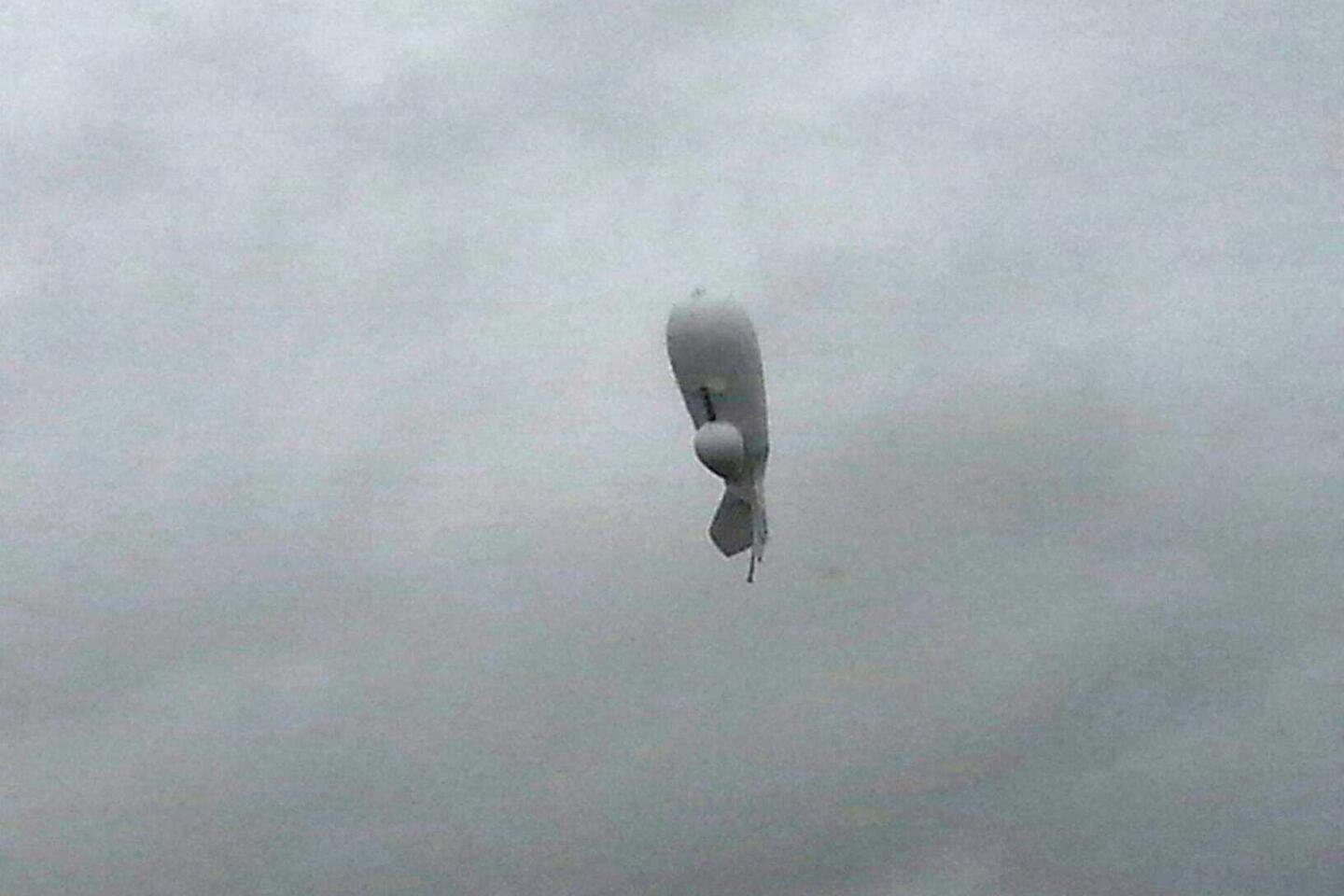Pentagon suspends troubled missile defense system at center of ‘runaway blimp’
The Pentagon has suspended indefinitely a trial run of the troubled missile defense system called JLENS, whose giant, radar-carrying blimps were intended to help safeguard the skies over Washington.
The three-year “operational exercise” has been a financial lifeline for JLENS, arranged by supporters of the program after Army leaders tried to kill it.
Any decision whether to resume the exercise will wait until after the Army has completed an investigation into how one of the pilotless blimps broke away from its mooring station in Maryland last week and flew uncontrolled over parts of two mid-Atlantic states, military officials said Tuesday.
“It’s going to be a complete and thorough investigation, and it takes time,” Army spokesman Dov Schwartz said.
The mishap Wednesday provoked fresh questions about the worth of JLENS, which has cost taxpayers more than $2.7 billion. The runaway blimp soared over Maryland and Pennsylvania, dragging a 6,700-foot-long mooring cable behind it. The cable clipped power lines, leaving thousands of people without electricity and disrupting civil aviation, before the blimp came to rest outside rural Moreland Township, Pa.
NEWSLETTER: Get the day’s top headlines from Times Editor Davan Maharaj >>
Army Maj. Beth R. Smith, speaking for the North American Aerospace Defense Command, said: “Future actions regarding the JLENS exercise will be made following the conclusion of the investigation.”
As lawmakers of both parties seek to trim $5 billion from President Obama’s proposed $612-billion defense budget, senior Democrats on the House Armed Services Committee are, for the first time, openly assailing any further spending on JLENS.
The system is designed to provide early detection of cruise missiles, drones and other low-flying threats, but it has struggled to track flying objects, to distinguish friendly from threatening aircraft and to communicate with the nation’s air defense networks.
“What we need is an unbiased investigation into JLENS incompetence,” Rep. Jim Cooper of Tennessee, one of the committee’s most senior Democrats, said in a statement to the Los Angeles Times. “We should defend the U.S. from low-flying threats, but this seems a stupid way to do it.”
Now is the perfect time to get rid of a ‘zombie program’ that doesn’t provide an advantage over aircraft that we’ve already bought.
— Rep. Jackie Speier (D-Hillsborough)
When Cooper questioned House Armed Services Chairman Mac Thornberry (R-Texas) about JLENS in a private meeting of members and staff Monday, Thornberry made clear that Republicans still back the system, according to Democratic aides who attended. A spokesman for Thornberry confirmed the exchange.
Bay Area Democrat Jackie Speier, another committee member, said in a statement: “As we cut $5 billion from the defense budget this week, JLENS should be the first thing to go, but inexplicably Republicans decided it wasn’t worth eliminating. Now is the perfect time to get rid of a ‘zombie program’ that doesn’t provide an advantage over aircraft that we’ve already bought.”
Speier, referring to disclosures in a Los Angeles Times article published in September, pointed to the pivotal role played by the nation’s then-No. 2 military officer in saving JLENS after senior Army officials tried to kill the program in 2010.
Marine Corps Gen. James E. “Hoss” Cartwright, then vice chairman of the Joint Chiefs of Staff, argued that JLENS held promise for enhancing the nation’s air defenses. At his prodding, money was found in 2011 for the three-year operational exercise above Washington, The Times reported.
Cartwright retired the same year. Five months later, he joined the board of Raytheon Co., the prime contractor for JLENS. As of the end of 2014, Raytheon had paid him more than $828,000 in cash and stock for serving as a director, Securities and Exchange Commission records show.
Speier called Cartwright’s prompt transition “an egregious example of the corrupting nature of the revolving door for military generals who then go on to serve on defense contractor boards.”
The operational exercise, which is costing taxpayers about $50 million a year, involved two JLENS blimps floating up to 10,000 feet high. It was to begin in January. But problems, notably with computer software, delayed the launch of a required second blimp until mid-August.
JLENS is short for Joint Land Attack Cruise Missile Defense Elevated Netted Sensor System. The 242-foot-long blimps operate in pairs. One searches widely for threats. The other is supposed to transmit “fire control” data on the location, speed and trajectory of threatening objects so U.S. fighter jets or ground-based rockets can shoot them down.
A 2012 report by the Pentagon’s Operational Test and Evaluation office faulted the system in four “critical performance areas” and rated its reliability as “poor.” A year later, in its most recent assessment, the agency again cited serious deficiencies and said JLENS had “low system reliability.”
ALSO:
Quentin Tarantino says police boycotts don’t intimidate him: ‘I’m not a cop hater’
Super volcano? The Big One in Wyoming? A huge gash in Earth has folks talking
Head of money-losing L.A. County Fair Assn. made nearly $900,000 in total compensation
More to Read
Sign up for Essential California
The most important California stories and recommendations in your inbox every morning.
You may occasionally receive promotional content from the Los Angeles Times.












